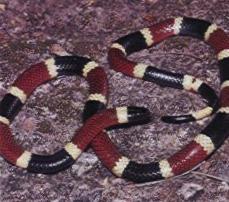
Coral Snake

Background: Approximately 40-50 species of venomous coral snakes exist in North and South America, with the greatest variety from Mexico to northern South America. A number of African and Asian coral snake species also exist. All coral snakes belong to the family Elapidae; Micrurus fulvius fulvius (eastern coral snake) and Micrurus fulvius tenere (Texas coral snake) are the most important species in the US.
Another US coral snake is Micruroides euryxanthus (Sonoran coral snake), but this is a relatively innocuous snake and no deaths have been attributed to its bite.
Coral snakes tend to be relatively shy creatures and bites are uncommon. Coral snakes account for less than 1% of venomous snakebites in the US. Most people bitten by coral snakes are handling them intentionally. Most bites occur in the spring or fall.
Pathophysiology: The coral snake venom apparatus is comprised of a pair of small, fixed, hollow fangs on the anterior aspect of the mouth through which the snake conducts venom via a chewing motion. Unlike pit vipers, such as rattlesnakes, copperheads, and cottonmouths, which strike quickly, coral snakes must hang on for a brief period to achieve significant envenomation in humans.
Coral snake venoms tend to have significant neurotoxicity, inducing neuromuscular dysfunction. They have little enzymatic activity or necrotic potential compared to most vipers and pit vipers. These venoms tend to be some of the most potent found in snakes, yet the venom yield per animal is less than that of most vipers or pit vipers. Because of the relatively primitive venom delivery apparatus, as many as 60% of those bitten by North American coral snakes may not be envenomed.
Frequency:
Mortality/Morbidity: No deaths related to coral snake bites have been reported in the US since coral snake antivenom became available. Before that time, the estimated case fatality rate was 10%, and the cause of death was respiratory or cardiovascular failure. Patients who survive the bite may require respiratory support for up to a week and may suffer persistent weakness for weeks to months.
History:
Physical: